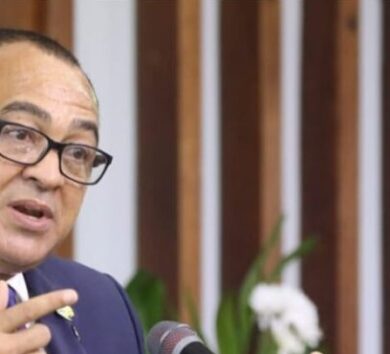

The Bank of Jamaica held its Quarterly Monetary Policy Report in Montego Bay, St James on Wednesday, August 21.
Below is the presentation made by the Governor of the Bank of Jamaica, Richard Byles, at that press conference:
Good morning and welcome to our Quarterly Monetary Policy Report press conference.
We are pleased to be conducting this press conference in Montego Bay and will, later today, engage in discussions with key stakeholders in the northwestern region of the island.
Bank of Jamaica recognises that its policies and operations affect various stakeholders differently. We are therefore committed to maintaining an outreach programme that gives voice to a wide cross-section of stakeholders. In Kingston, we maintain an active engagement with various private sector groups, including the banking community, for which we have supervisory oversight as part of our statutory mandate. We have also in the past directly engaged with the citizens and businesses of central Jamaica. The Bank has, in fact, held its quarterly monetary policy press conference in Montego Bay before, with the last one having been held in May 2017. We will seek to replicate this outreach in other communities over time.
I will now speak on the Bank’s monetary policy, the MPC’s recent decision and outline some of the considerations that led to its decision.
Monetary Policy Decision
The Bank’s Monetary Policy Committee met on the 16th and the 19th of August and announced its decision yesterday to continue a gradual easing of its monetary policy stance. Effective today, the 21st of August, the Bank has reduced its policy rate by 25 basis points to 6.75 per cent. We will also continue to gradually reduce BOJ’s absorption of liquidity from DTIs through our open market operations and will continue to strive to preserve the stability in the foreign exchange market. Our previous decision, announced on the 28th of June 2024, to gradually reduce the absorption of liquidity, has already resulted in an injection of approximately $21 billion into the system and a 105-bps reduction in interest rates on BOJ’s 30-day Certificates of Deposit. As a consequence, Treasury Bill rates also fell over the same period.
The decision to further ease the monetary policy stance reflects the Committee’s view that headline inflation is becoming more anchored in the Bank’s target range of 4.0 to 6.0 per cent. While there will be an uptick in headline inflation over the next three to five months (August to December 2024), caused by the impact of Hurricane Beryl, this uptick will be temporary. The Committee also noted that economic conditions are generally supportive of low, stable and predictable inflation in the future.
Economic Conditions Underpinning Inflation
I will now briefly discuss the recent inflation data and outlook and the economic conditions underpinning them.
On August 15, STATIN reported that Jamaica’s annual headline inflation at July 2024 was 5.1 per cent. This outturn was below the Bank’s most recent forecast and represents the fifth consecutive month in which inflation fell within the Bank’s target range. One measure of core inflation that excludes the prices of agricultural food products and fuel prices from the CPI, was 4.5 per cent at July 2024, representing a progressive lowering of underlying inflation since the start of 2024.
The MPC notes that, as stated by the Government, domestic fiscal policy will address the post-hurricane recovery efforts by utilising existing savings and insurance, and by re-prioritising its expenditure envelope. In this context, the MPC is of the view that fiscal policy will continue to pose no risk to inflation over the near term. In addition, the lagged impact of the Bank’s relatively tight monetary policy posture also continues to have an impact on the economy.
Against this background, domestic demand conditions are moderating, as reflected in selected sectors of the economy and in easing wage pressures. Real GDP for the March 2024 quarter grew by 1.4 per cent, which was lower than the growth for the December 2023 quarter, and there are signs that economic growth slowed further in the June 2024 quarter. When the underlying direction of economic activity and the impact of the hurricane in July are taken into account, GDP for the September 2024 quarter is projected to contract when compared with the September 2023 quarter.
Against the background of the lower economic growth, the net flow of new domestic currency loans to the private sector for the June 2024 quarter was lower than the flows in both the March 2024 and the June 2023 quarters. The net flow of loans is the difference between total disbursements and total repayments. A reduction in loan disbursements to the business sector was the principal factor behind the fall in net flows and was consistent with a continued tightening in credit terms offered by the banking sector.
By almost all measures, inflation expectations in Jamaica appear to be on a consistent downward path. In Bank of Jamaica’s June 2024 survey of businesses’ inflation expectations, respondents lowered their expectations for inflation 12 months ahead to 7.6 per cent from 8.2 per cent, a continuation of the decline trend since the middle of 2022. The measure “inflation expectations” is an important barometer of future price changes as these expectations affect the way businesses and consumers approach their decisions to either set their prices, or demandwage adjustments.
Expectations about exchange rate depreciation have also fallen appreciably, as reflected in the pricings in financial markets as well as responses to survey questions. As a result, the dollarization of deposits in commercial banks, or how much of these deposits are held in US dollars, has fallen noticeably over the past 25 months. At the current level of slightly less than 40 per cent, dollarization is currently tracking below its pre-pandemic level.
The exchange rate has been fairly stable, depreciating by only 1.4 per cent on a year-over-year basis at 12 August 2024. The Bank has maintained an appropriate presence in the foreign exchange market, which has supported the stability in the market. The surplus on the current account of the balance of payments for the December 2023 quarter, as well as the positive outlook for the balance of payments over the next year, underpins the relatively strong flows in the foreign exchange market and the relative stability in the exchange rate. BOJ sold US$966 million via its B-FXITT facility over the 12 months to end-July 2024. When these sales are set against BOJ purchases, the result is that the Bank net purchased approximately US$1.3 billion over the period, resulting in Net International Reserves of US$5.1 billion as at end-July 2024.
The Bank will continue to act to ensure orderly movements in the exchange rate.
The domestic price level has also been favourably supported by some international commodity prices as well as by the continued reduction in inflation in the United States. The international prices for grains (including wheat, corn and soybeans) during the June 2024 quarter were lower, on average, by close to 22 per cent, compared to the June 2023 quarter. Inflation in the US fell to 2.9 per cent at July 2024 from 3.2 per cent a year earlier, and from 9.1 per cent at July 2022. For Jamaica, lower grains prices and lower US inflation reduce the pace of increase in import costs and increase the likelihood of a reduction in interest rates in the US, all of which benefit our economy. Energy and shipping prices have, however, fluctuated and we will need to keenly watch this issue going forward.
Update and Outlook for the Jamaican Economy
Hurricane Beryl
I think it is appropriate to start the discussion of the inflation forecast with an observation on the passage of Hurricane Beryl. As you are aware, Jamaica’s resilience was tested by the passage of Hurricane Beryl in July. The hurricane impacted the Island on the 3rd of July as a category four storm with maximum windspeeds of 230 kilometres per hour. Infrastructure damage to schools, roads, electrical networks and telecommunication systems from Hurricane Beryl is estimated to be significant. Preliminary estimates of the damage and loss to the Agriculture and Fisheries sector is $5.7 billion (0.2 per cent of GDP). Crops in the traditional farming parishes such as St. Elizabeth, Manchester, Trelawny, St. Ann and Clarendon were the most severely impacted. The tourism sector was also negatively impacted by a 4-day closure of Jamaica’s international airports in the wake of the hurricane and the consequential temporary cessation of travel to the Island.
As I mentioned earlier, the projection for inflation to temporarily rise from its current level and breach the upper end of the Bank’s target range between August and December 2024, largely reflects the negative impact of Hurricane Beryl on agricultural supplies and related increases in other consumer prices. Following this shock, inflation is projected to return to the target range shortly after the December 2024 quarter.
In relation to demand conditions, for FY2024/25, the Bank projects that real economic activity will be in the range of –1.5 to 0.5 per cent while real GDP for FY2025/26 is projected to grow by 1.5 to 3.5 per cent. The projection for FY2024/25 largely reflects the anticipated adverse impact of Hurricane Beryl on the economy and is underpinned by contractions for Agriculture, Forestry & Fishing and Construction. The outlook for FY2025/26 reflects a partial rebound in economic activity following the declines in FY2024/25.
The risks to the inflation outlook are balanced (which means that inflation is likely to be in line with projections). Rising international shipping costs, worse than anticipated impact of Hurricane Beryl and other adverse weather conditions could influence higher inflation. However, the factors that could result in lower-than-projected inflation include weaker-than-projected global growth, which could reduce domestic demand and imported inflation.
In concluding its discussions, the MPC noted that any future monetary policy decision to reduce interest rates will continue to depend on incoming data.
Concluding Statement
Ladies and gentlemen, the primary mandate of Bank of Jamaica is to maintain inflation firmly between 4.0 and 6.0 per cent and we remain resolute in this commitment.







Comments